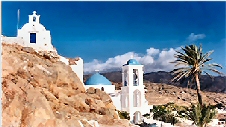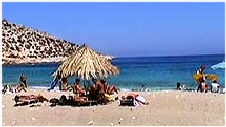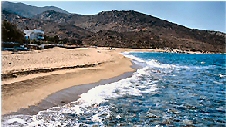Ios the Party Island
The Enfant Terrible of the Greek islands, Ios island, the height of the sea, sex and sun.
 The Enfant Terrible of the Greek islands, Ios island, the height of the sea, sex and sun, is one of the
Cyclades island group on the Aegean Sea in Greece. It is a famous tourist destination, attracting visitors
with its golden beaches and the characteristic Aegean architecture. Ios is well known as the party island
with the lively atmosphere and the endless fun.
The Enfant Terrible of the Greek islands, Ios island, the height of the sea, sex and sun, is one of the
Cyclades island group on the Aegean Sea in Greece. It is a famous tourist destination, attracting visitors
with its golden beaches and the characteristic Aegean architecture. Ios is well known as the party island
with the lively atmosphere and the endless fun.
The site of the village is on the hill-top, first so as to make it possible to see the pirates approaching and take evasive action, and second to secure even the smallest piece of land where a crop might be planted.
The main residential area is Chora, with her narrow streets, wisely oriented, so as to -protect from the open sea winds, with covered spaces to shelter from the strong sunbeams of summer and the heavy rainfalls of winter.
 Tiny cube shaped houses like sugar lumps crowded around small squares, whitewashed churches topped with
brilliant azure cupolas. The island has 365 churches as many as the days of the year, most of them are
Byzantine. Everything is painted white, to resist the merciless heat of Greek summer, with blue or green
doors and windows to rest the vertical and horizontal lines, softened by gentle curves combining the blue
of the Aegean sea.
Tiny cube shaped houses like sugar lumps crowded around small squares, whitewashed churches topped with
brilliant azure cupolas. The island has 365 churches as many as the days of the year, most of them are
Byzantine. Everything is painted white, to resist the merciless heat of Greek summer, with blue or green
doors and windows to rest the vertical and horizontal lines, softened by gentle curves combining the blue
of the Aegean sea.
Archaeological findings show that the island has been inhabited since the early Cycladic period. There are elements that bear witness to the presence of Careans, Pelasgians, Achaeans and Phoenicians, who gave the island the name "Phoenicia". The Ionians came and settled to the island in 1050 B.C. The island has been related with the death of the poet Homer, creating a myth that in the course of the centuries turned into a tradition.
 During the classical period, Ios joined its forces with the Athenian League to avoid being occupied by the
Persians, and thus established a democracy. In 338 B.C. after the battle of Cheroneia, Ios came under the
rule of Macedonia, and in 315 B.C. regained its independence and became an equal member of the "Islanders'
Community". In the 2th century B.C., the Romans occupied Ios and used it as a place of exile. In Byzantine
period, the Christians built many churches on the foundations of the pre-existing paganistic temples. For
some time the island suffered a lot from the pirate raids. In 1204 Ios was occupied by the Crusaders, and
up to the 15th century it was ruled by the noble family of Crispi, forming part of the Duchy of Naxos. But
in 1537, Hairedin Barbarossa, the Duchy of Naxos, together with Ios. In 1770 the islanders sided with the
Russians, who were at war with the Turks, in order to regain its freedom. At that time the island had 1400
inhabitants. In 1821, Ios took part with 24 equipped ships in the War of Independence against the Turks,
The final liberation came with the incorporation of Ios in the modern Greek State, which was founded by the
signature of the protocol of London on the 10th of March 1829.
During the classical period, Ios joined its forces with the Athenian League to avoid being occupied by the
Persians, and thus established a democracy. In 338 B.C. after the battle of Cheroneia, Ios came under the
rule of Macedonia, and in 315 B.C. regained its independence and became an equal member of the "Islanders'
Community". In the 2th century B.C., the Romans occupied Ios and used it as a place of exile. In Byzantine
period, the Christians built many churches on the foundations of the pre-existing paganistic temples. For
some time the island suffered a lot from the pirate raids. In 1204 Ios was occupied by the Crusaders, and
up to the 15th century it was ruled by the noble family of Crispi, forming part of the Duchy of Naxos. But
in 1537, Hairedin Barbarossa, the Duchy of Naxos, together with Ios. In 1770 the islanders sided with the
Russians, who were at war with the Turks, in order to regain its freedom. At that time the island had 1400
inhabitants. In 1821, Ios took part with 24 equipped ships in the War of Independence against the Turks,
The final liberation came with the incorporation of Ios in the modern Greek State, which was founded by the
signature of the protocol of London on the 10th of March 1829.
The Port of Ios is at the head of the Ormos harbor in the northwest. From there the bus or a 15-minute walk, up the steep donkey path takes you to the village, known as Chora. Chora is a white and very picturesque cycladic village, full of stairs and narrow paths, that makes it inaccessible for cars of any kind. Today, the main path through this village is completely taken over by tourism in terms of restaurants, boutiques, bars and discotheques. Apart from the port and the village of Chora, Ios has only a few small settlements, just a group of spread out houses in the background of the major beaches.

Places of attraction :
- Chora, island's main settlement
- Yialos, the islands Port
- Mylopotas Beach
- Agia Theodoti Beach, taverns and rooms to rent, church of Agia Theodoti
- Pirgos, the highest peak of the island and 16th century Byzantine church of Aghios Ioannis
- Paleokastro, where the old Byzantine castle lies, with the church of Panagia Paleokastritissa (Our lady of the Old Castle)
- Psathi, a small village well-situated on the most fertile spot of the island, with a few taverns and rented rooms, and its beach
- Plakoto Beach
- Tomb of Homer, on the way to Plakoto Beach
- Klima Beach
- Kalamos Beach, just after the Monastery of Kalamos, a very well-preserved 200-year-old building, a special place of worship for the locals.
- Tris Klissies Beach, three beautiful secluded beaches, accessible only on foot.
- Manganari Beach, four of the most beautiful beaches in the Aegean, each one lying next to the other, wait for the visitor to enjoy their peaceful nature. There are many seaside taverns where you can taste fresh fish, as well as good accommodation.
- Pano Kambos, a fertile valley rich with vineyards and olive trees.
May 04, 2009
